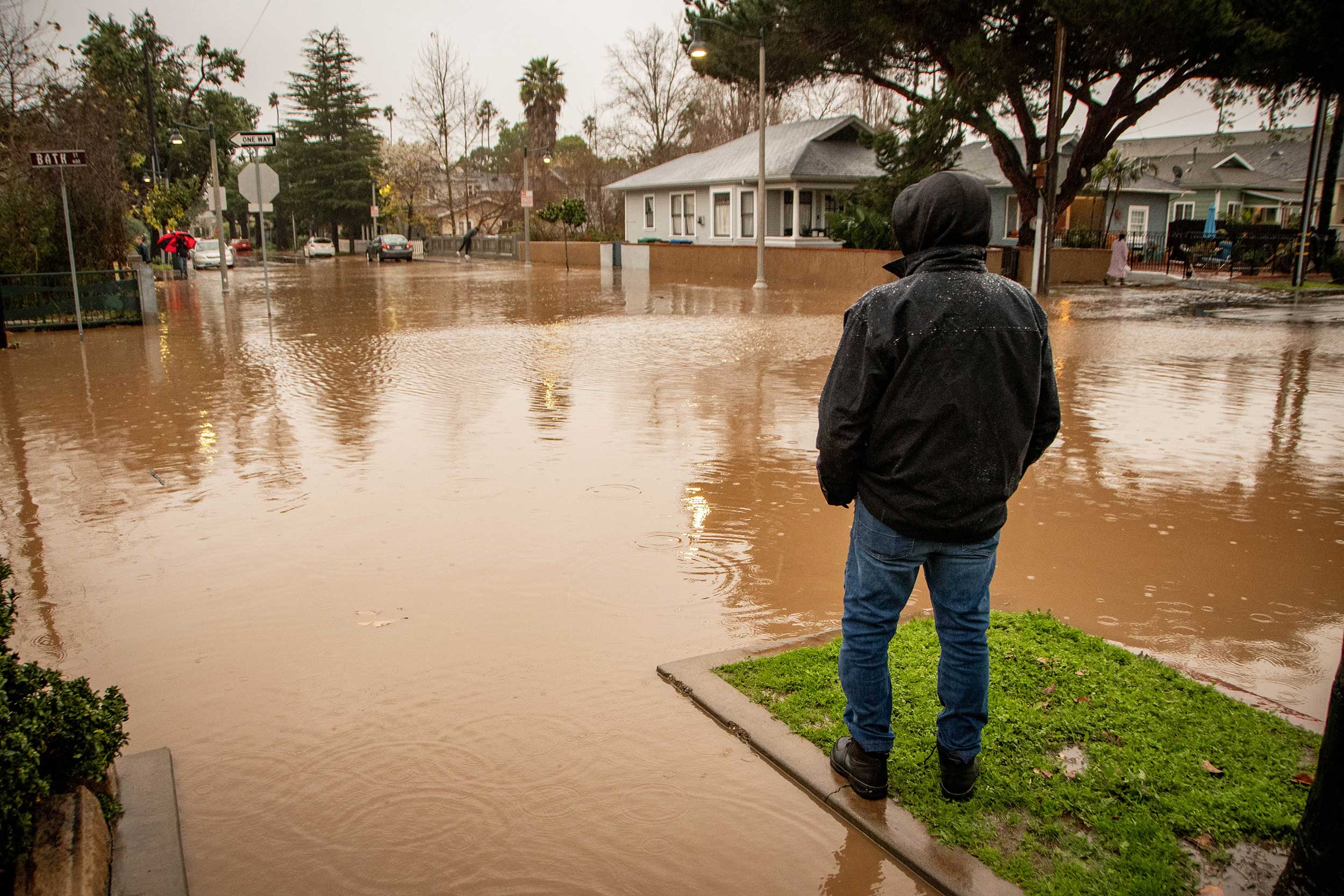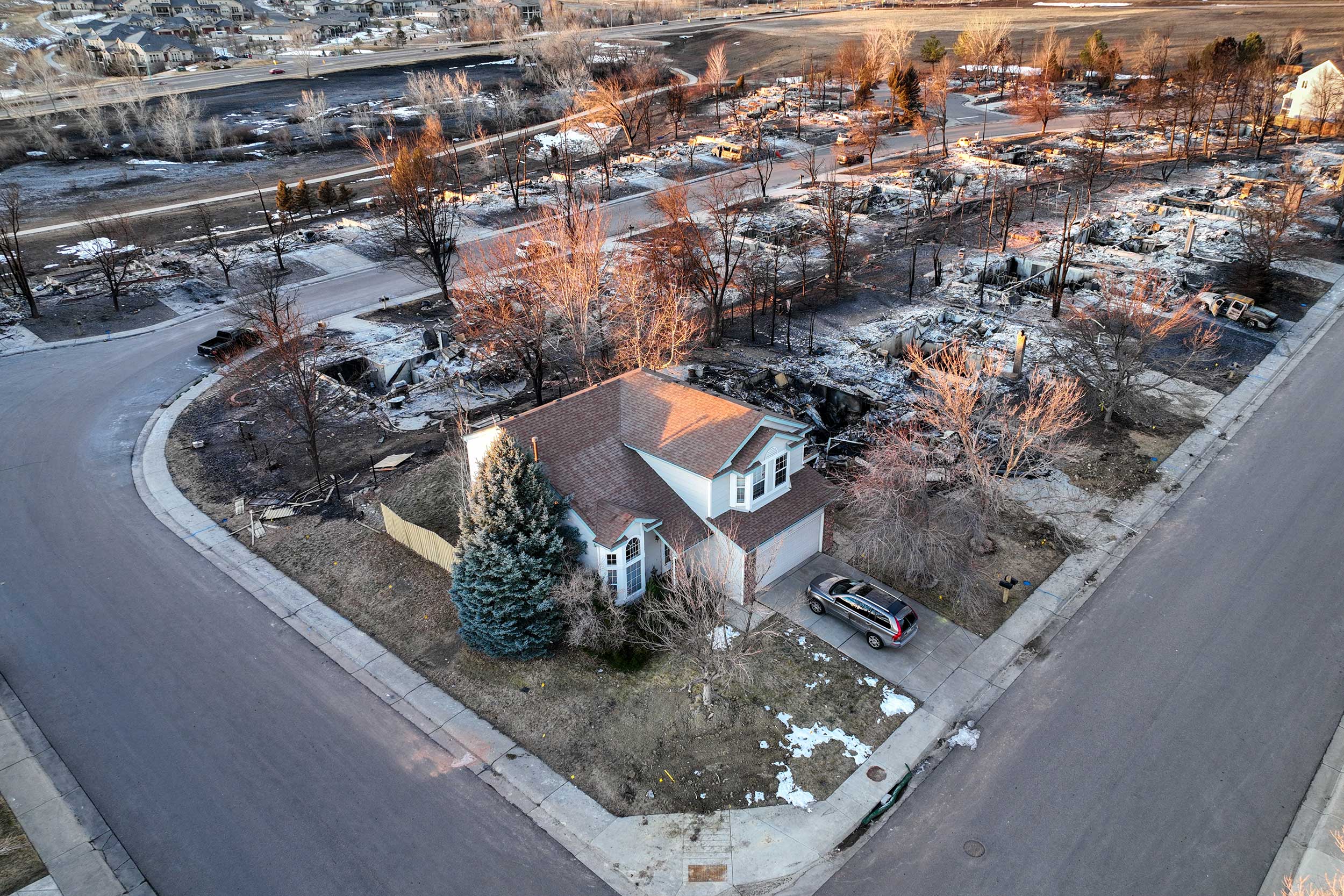Hey team, and welcome back to one5c. When we logged off for the weekend on Friday, we’d planned to talk about California in this morning’s newsletter, but not for the reason you’d think. Our original digest included a look at The Golden State’s soon-to-be-enforced plastic pollution law, which, in addition to ambitious recycling goals, includes a mandate to make less plastic to begin with—a first in the U.S.
We’ll get back to that one day soon, but this morning California is in trouble. Sara Kiley’s on top of this developing story. —Corinne
WHAT WE’RE INTO THIS WEEK
By Sara Kiley Watson

A flooded intersection in Santa Barbara, California. ERICK MADRID/EPA-EFE/Shutterstock
Weather alert
Atmospheric river wallops California
Sunday was Southern California’s wettest day in 20 years, and, as of this morning, more than 14 million people across the region are seeing a forecast for excessive downpours: Parts of Los Angeles are expected to receive around half a year’s worth of rain in the next few days. This is all due to a massive atmospheric river crawling across the West Coast. Atmospheric rivers are long, narrow regions of the atmosphere that carry loads of water vapor from the already moist tropics to drier climes—we’re talking around 20 times the amount of H2O in the Mississippi River, according to CNN. Add in record-warm air and ocean temperatures, and these storms only intensify. Scientists argue that the atmospheric river currently flooding the megadrought-recovering region is being made worse by both El Nino conditions and human-caused climate change.
Report card
Patagonia’s mountainous donations
Patagonia cemented its public rep as the capital-S sustainable business when founder Yvon Chouinard relinquished ownership of the company in 2002 and promised all future profits to environmental and climate causes. According to a New York Times review of tax filings and internal documents, we can now see how well they’ve followed through on that pledge: The clothing company has donated more than $71 million to groups like EarthJustice and efforts to protect Albania’s Vjosa River and Alaska’s Bristol Bay. A chunk of cash has also gone to more indirect planet-saving action, including to super PACs like the House Majority PAC and the Senate Majority PAC. Unfortunately, though, there’s no way to guarantee that funds from the latter aren’t going to support not-so-climate-friendly folks like Joe Manchin.
Good read
The climate case for mining jobs
A robust supply of precious metals is a necessity for our growing clean energy needs, which means we’re going to need a whole lot more geoscientists and mining engineers. But the industry’s long rap sheet—marked by ecosystem damage and exploitation—has meant a steady drop in grads with training in that particular kind of work. In fact, graduation rates in those fields have been on a downslide since the ’80s, and have dropped 39% since 2016. Still, as Maddie Stone reports for Grist,there are startups looking to dig into a more ethical, sustainable way to mine these much-needed resources—and make geoscience careers and degrees rock solid again.
Key players
The new climate chief in town
Last week, the White House announced that John Podesta, a veteran political consultant and one of the big brains behind the Inflation Reduction Act, will take on John Kerry’s role as the nation’s top climate diplomat. Podesta has been Biden’s go-to on domestic climate policy and rollout, but we get that he’s somewhat less familiar to Jane Q. Public than an ex-presidential candidate and famed animal lover like Kerry. To get to know about the man behind the name that’s sure to sprinkle climate coverage for at least the next few months, we recommend checking out Bill McKibben’s interview with Podesta in The New Yorker last spring.
Mic-drop climate stat

How long the fossil fuel industry has known about the impending climate disaster caused by their products, according to documents uncovered in a recent DeSmog investigation.
Cultural climate
Why GoFundMe fumbles disaster relief, and what to do instead
By Glorie Martinez

The aftermath of the Marshall Fire in Colorado Gabe Shakour/Shutterstock
In 2022 alone, weather-related damages forced more than 2 million Americans out of their homes. With human-caused warming spurring more frequent and extreme natural disasters (like the one unfolding now in California), crowdfunding platforms like GoFundMe have increasingly become a go-to for people trying to rebuild. But there’s a catch: In a country struggling with wealth inequality, the platforms can make existing disparities worse.
Recent preprint research in the Social Science Research Network indicates that GoFundMe donations mostly benefit high earners. The authors looked specifically at the aftermath of the 2021 Marshall wildfire in Colorado. There, households with incomes higher than $150,000 received 28% more funds on average than those earning less than $75,000. Another 2020 study in the same journal found that medical campaigns from wealthy urban areas in the U.S. received more donations than those of lower-income and less socially connected residents. Can there be a better way?
Why does this happen?
It’s easy to understand the appeal of crowdfunding relief. Federal disaster aid often overlooks vulnerable groups like low-income communities and people of color, and insurance companies tend to jack up premiums or even deny coverage in some climate-stressed situations and locations.
The rub with individuals giving cash directly to survivors trickles down from the fact that platforms like GoFundMe rely on campaign organizers to self-promote. People usually get support from folks they know, rather than random internet users, the study authors say. High-income households tend to have wealthier social circles, which naturally lead to heftier donations. Disaster survivors with lower incomes might not have an extensive social network to get donations from—and their family, friends, and neighbors might need help themselves.
What can we do instead?
Looking at shortfalls in crowdfunded health care offers a window on how individuals can help provide disaster relief. Nora Kenworthy and Mark Igra, who studied crowdfunding inequality during COVID-19, told the New York Times in 2021 that online charity platforms risk drawing attention and funding away from traditional charities. And GoFundMe’s CEO has warned that person-to-person donation platforms aren’t a replacement for social services that provide essentials like food, water, and medical care.
That’s why staying civically engaged—through voting, volunteering, protesting—is essential to creating towns, states, and countries that are more equitable places. In terms of where to put your dollars when disasters happen? Websites like Charity Navigator can be helpful in finding reliable, reputable organizations that get cash to where it’s most needed. For climate disasters, specifically, Direct Relief delivers medical assistance to communities, and All Hands and Hearts provides volunteer-led rebuilding and infrastructure assistance.
